As leaves start to drift from the trees and the air turns crisp, fall ushers in a beautiful change in scenery. It’s a time when many animals prepare for the winter ahead. Some gather food, while others grow thick coats to ward off the chill. As you explore the outdoors during this season, you’ll likely encounter various animals going about their autumn routines. In this article, we’ll explore the world of animals that you might see in the fall months in the US.
1. Monarch Butterfly (Danaus plexippus)

One of the most iconic animals you’ll see in the fall in the United States is the monarch
butterfly
.
©Nancy J. Ondra/Shutterstock.com
During the fall in the US, you’re likely to encounter the easily recognizable monarch butterfly. This eye-catching insect sports bright orange and black wings that have a span of around four inches.
Surprisingly, despite their seemingly fragile nature, monarch butterflies can reach heights of up to 10,000 feet while flying. This is particularly useful when they embark on long migrations.
Commonly found in open spaces like fields, grasslands, and roadside areas across much of North America, these butterflies have specific diets. The young caterpillars feed solely on milkweed plants. On the other hand, the adults draw nectar from various flowers, including milkweed, aster, and thistle.
As the weather turns cold, monarchs make an extraordinary journey to warmer climates, specifically Central Mexico, a trip that can span 3,000 miles. During their travels, they make pit stops to recharge their energy from flowers that provide nectar.
Best Places to See Monarch Butterflies in the Fall
- In Texas, look for them as they move south, driven by cold winds.
- If you’re in Minnesota, planting nectar-rich plants in your yard could serve as a butterfly magnet.
- California residents, particularly in the central and southern regions, can see them as they head towards the Pacific coast.
- Finally, New York’s Fire Island is a hot spot for monarch sightings from mid-August to early October due to its location along a critical migration route.
2. Elk (Cervus canadensis)
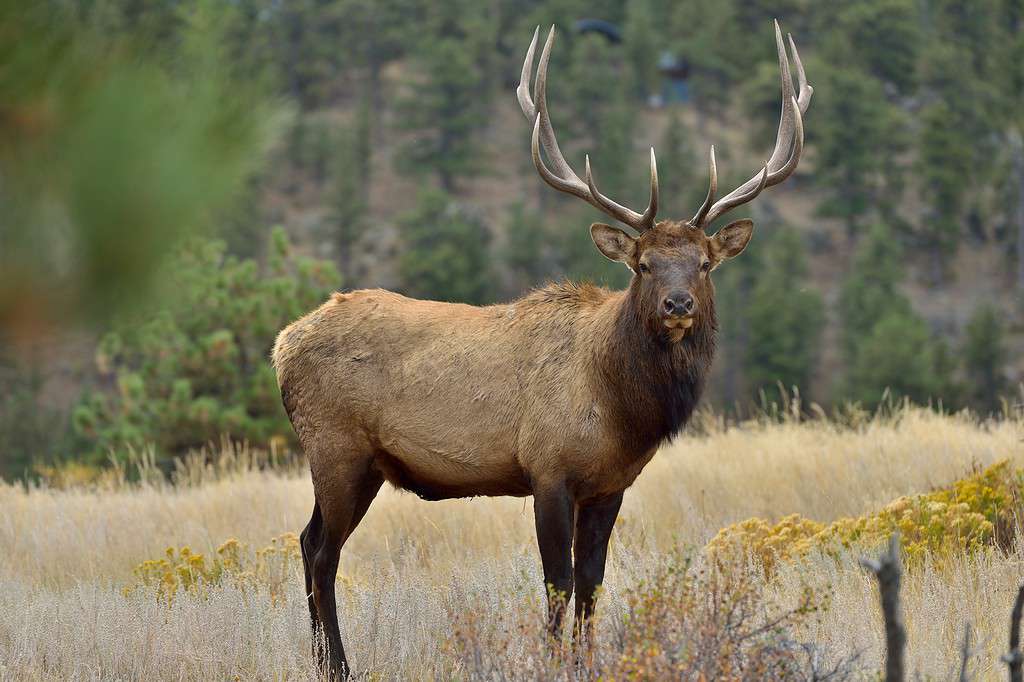
Another animal that you might be able to see in the fall is the elk, a majestic creature native to North America.
©SeanXu/ iStock / Getty Images Plus via Getty Images
The elk, sometimes called wapiti, is a large, awe-inspiring animal native to North America that you’ll likely see during the fall.
These creatures have thick fur that’s brown with a touch of red. They also have a unique cream-colored patch near their tails. Male elks are pretty big, standing about five feet at the shoulder and weighing more than 700 to 1,000 pounds.
While these animals generally prefer forested areas and the edges of woods, especially in hilly landscapes, you can also find them in meadows, open plains, and secluded valleys. However, elks generally avoid extremely cold or hot regions like the tundra and deserts.
Elks are plant-eaters, and they mainly feed on grass, but they’ll also munch on bushes, small twigs, and leaves.
Mating season, commonly known as the rut, happens in the fall. During this period, male elks try to win over females with their calls, known as bugling. This is also when they move from higher elevations to lower grasslands for their yearly mating rituals. Male elks compete to earn the privilege of mating with a group of females. Also, this high-stakes period is most active from mid-September to mid-October.
Best Places to See Elks in the Fall
- Yellowstone National Park: Fall is a great time to see elks in Yellowstone, where they’re active in lower-elevation meadows during mating season.
- Great Smoky Mountains National Park: Even though the elks here were reintroduced, you can still catch sight of their fall mating behaviors.
- National Elk Refuge: As the fall turns into winter in November and December, elks move to this refuge, offering a perfect opportunity to watch them.
3. North American Beaver (Castor canadensis)

You might be able to see North American beavers in the fall, gearing up for winter, building and fixing dams.
©Holly Kuchera/Shutterstock.com
The North American beaver is a remarkable animal to watch, especially when the leaves start to change color in the U.S.
These beavers have sturdy frames and fur that can vary from a yellowish-brown to almost black. One of their standout features is their wide, flat tails covered in scales, along with large, ever-growing orange teeth. Generally, they measure between 3 and 4 feet long and about 1 foot tall.
You’ll mainly find these creatures in marshy environments throughout a good portion of North America. They live near bodies of water like rivers, lakes, and streams, and they’re also known for the ponds they create by building dams. North American beavers eat a plant-based diet, primarily focusing on the inner layers of bark, small branches, new growth, and leaves from trees like aspens, willows, and poplars.
Beavers are busiest in the fall as they gear up for winter. They build and fix dams, often prompted by the noise of flowing water. During the late fall, they collect and store tree limbs underwater, which serves as their winter food supply. This underwater stash is crucial for them, particularly when other sources of food are hard to come by due to icy conditions.
Best Spots to See Beavers in the Fall
- Montana: You can often find beavers in Lolo National Forest near Missoula, close to various water sources.
- Maine: Beavers are commonly seen in Acadia National Park, particularly around sunrise or sunset near the freshwater lakes, the Sieur de Monts region, or while walking along the carriage trails.
4. Bald Eagle (Haliaeetus leucocephalus)
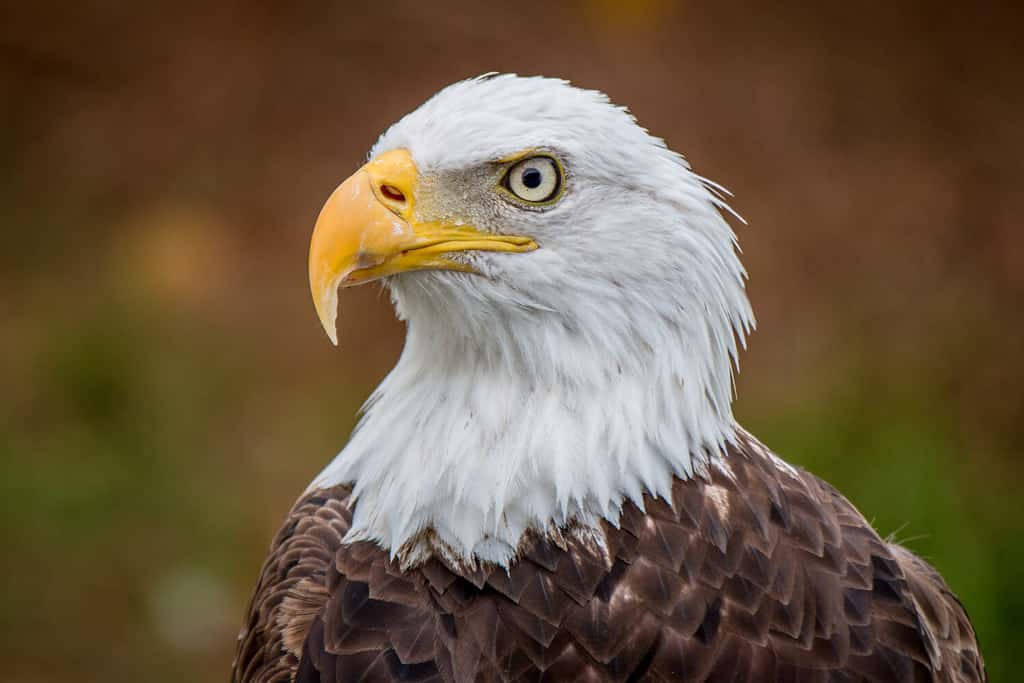
An iconic species, another animal that you might be able to see in the fall is the bald eagle, as they move south in search of food.
©Kevin Tubbergen/Shutterstock.com
The fourth animal on the list of animals that you might see in the fall is the majestic bald eagle.
Adult bald eagles are easy to recognize with their white tails and heads, dark brown wings and bodies, along with bright yellow beaks and legs. Younger ones have brown heads and tails, and their bodies and wings have patches of white. Typically, these eagles measure between 28 and 40 inches long, while their wingspan ranges from 6 to 7.5 feet.
These birds prefer to stay near water bodies that are rich in fish and are surrounded by forests. In colder months, you can often spot them around water that hasn’t frozen over or while they are hunting along shores, rivers, and water reservoirs. During their travel periods, you can find bald eagles near virtually any aquatic environment.
Though they primarily eat fish, bald eagles are also known to feed on dead animals or even snatch other types of prey.
As the cooler weather rolls in in the fall, bald eagles from northern regions of the U.S. and Canada start moving south. During this time, they look for spots where they can find fish, as waters in their usual territories begin to freeze.
Best Spots to See Bald Eagles in the Fall
- Conowingo Dam in Maryland: This is a go-to location on the East Coast for eagle spotting, especially as the weather turns colder.
- From October through July, bald eagles can often be seen nesting in East Texas and along the coastline stretching from Houston to Rockport.
- Additionally, states such as Florida, Alaska, and Minnesota are highly recommended for eagle watching, particularly during their fall migration season.
5. Moose (Alces alces)

One of the best times to see moose in the US is in the fall, as this is their mating season.
©equigini/iStock via Getty Images
Seeing a moose can be awe-inspiring, but it’s important to remember to keep your distance from this wild creature.
Moose have elongated heads with sizable noses and lips, along with small ears and a short tail. They also have a flap of skin, known as a dewlap, hanging from their necks. Their strong shoulders create a hunched look, and male moose boast wide, flat antlers that can span between 4 and 5 feet.
Because of their thick fur and substantial size, moose are best suited for colder environments. They’re often found in wooded areas near bodies of water like streams and ponds. Their diet consists solely of plant matter.
Fall in the U.S. is a perfect time to spot moose, as this is their mating season, known as the rut. Between late September and mid-October, male moose engage in various activities, such as scraping trees to remove the soft covering from their antlers and making small pits in the ground where they urinate to splash urine onto their antlers to attract females.
Best Spots to See Moose in the Fall
- Maine: Several regions like the Western Lakes, Kennebec Valley, Maine Highlands, and Aroostook County are great spots for moose-watching.
- Isle Royale, Michigan: This island, which you can reach only by ferry, private boat, or seaplane, offers a secure environment for moose.
- Northern New Hampshire and Massachusetts: Known as “Moose Alley” in New Hampshire and the Quabbin Reservoir in Massachusetts, these areas are also excellent for observing moose.
6. White-Tailed Deer (Odocoileus virginianus)
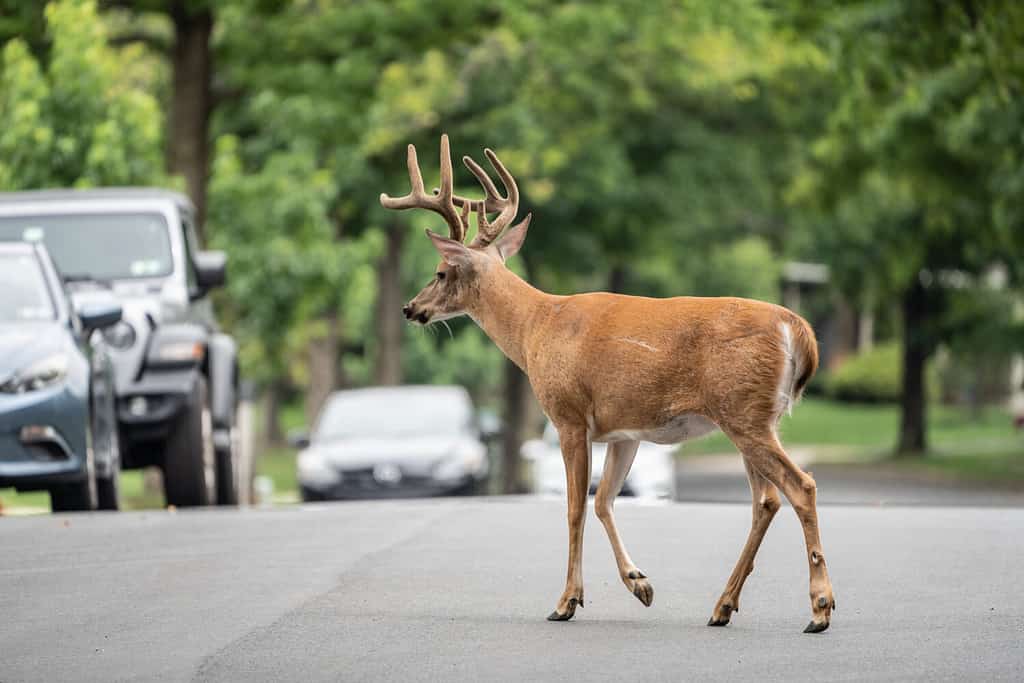
White-tailed deer are pretty widespread across the United States, and you’ll be able to see them in the fall.
©Amy Lutz/Shutterstock.com
In the summer, white-tailed deer sport a coat that’s either tan or brown, which turns to a grayish hue during winter. Their white markings are visible on their throats, facial area, belly, and the bottom of their tails, which is where they get their name. Males of this species are equipped with antlers, and their height at the shoulder generally ranges from 2.5 to 3 feet.
These deer are found across the U.S. mainland as well as much of southern Canada. While white-tailed deer like open woodlands, they can also be seen near the edges of cities and in rural areas. These animals are plant-eaters, casually feeding on various types of foliage.
Fall and winter are challenging seasons for white-tailed deer. Their primary concern is to avoid hunters while also searching for enough food to sustain them through the upcoming cold months.
Best Spots to See White-tailed Deer in the Fall
- New York: The state has a sizable population of white-tailed deer, making it a favorite location for both locals and tourists to watch these creatures in the fall.
- Farm Regions in the East and South: Areas like this are hotspots for observing white-tailed deer.
- Texas: The state stands out for its large number of white-tailed deer, offering over 1.6 million acres of public land for wildlife spotting.
7. Connecticut Warbler (Oporornis agilis)
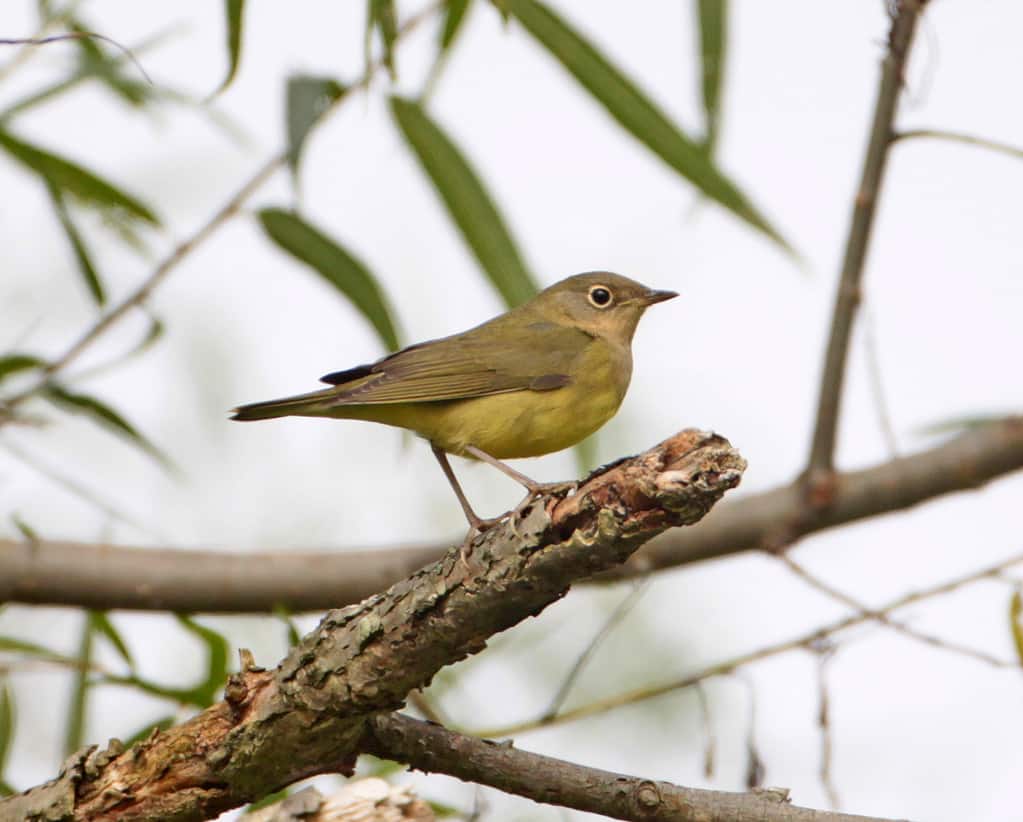
If you’re more of a bird person, you’re in luck! In the fall, you might be able to spot the Connecticut warbler.
©Matt Tillett from Cumberland, MD, USA / CC BY 2.0 – Original / License
Looking to add a special bird to your fall birdwatching list? The Connecticut warbler could be your prize. With a gray face, yellow underbelly, and olive-green back, this bird is understated but charming. It’s distinguished by its large bill and the light-colored ring around its eye. Instead of flying around, they usually walk on the ground to forage, often hiding in dense undergrowth.
Their preferred hangout spots are moist woods near bogs and meadows. They’re bug eaters mostly, but they’ll also dine on spiders and snails. You might even catch them enjoying some seeds or berries.
This warbler is a gem in the Eastern U.S. During fall, this bird migrates south to Florida before heading off to tropical locations. They start their journey quite early, with some leaving in mid-July, but you can still catch stragglers until mid-October.
If you’re hoping to spot one during their fall migratory journey, the Northeast U.S. is your best bet. Here, they make short stops to recharge before their big flight to South America.
Best Spots to See Connecticut Warbler in the Fall
- Southern New England: Seasoned birdwatchers have reported sightings during the fall months.
- Northeast Coast: You might get lucky at spots like Plum Island in Massachusetts or Cape May in New Jersey, but they’re usually seen a bit more inland.
- Fields full of weeds: From mid-September onwards, look in overgrown fields, especially those with lots of ragweed, for your best chance to see this elusive bird.
8. Humpback Whale (Megaptera novaeangliae)
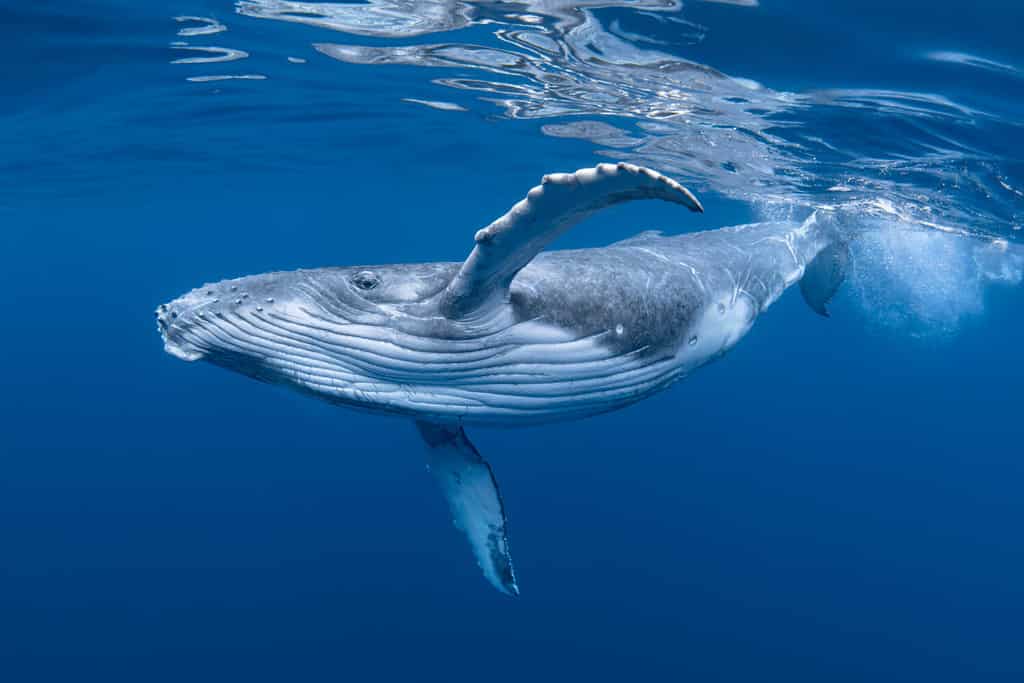
One of the most majestic creatures you’ll be able to see in the fall in the US is the humpback whale.
©Craig Lambert Photography/Shutterstock.com
If you’re eager to spot some incredible wildlife this fall, you won’t want to miss the humpback whale.
These giants have a dark body contrasted by a white underbelly, a tail, and long flippers. They’re known for being lively, often making a splash by slapping their fins and tails against the water. Fully grown, they can reach lengths of up to 60 feet.
You can find these magnificent creatures in various oceans, from the icy waters of the polar regions to the warm tropics. They’re meat-eaters, feasting mostly on krill and schools of small fish.
As the fall season rolls in, especially in North America, humpbacks focus on eating as much as possible before migrating to warmer seas for winter.
Best Spots to See Humpback Whales in the Fall
- The Outer Banks in North Carolina: Particularly around Cape Lookout, you’re likely to see humpbacks in the fall.
- Along the Massachusetts shoreline: You can spot these whales from March right up until November, which makes fall a great time for watching.
- Barnstable, Cape Cod, Massachusetts: This spot is a must-visit for whale enthusiasts, especially from spring to fall.
Summary of the Animals That You Might See in the Fall
| Number | Animal | Scientific Name |
|---|---|---|
| 1. | Monarch Butterfly | Danaus plexippus |
| 2. | Elk | Cervus canadensis |
| 3. | North American Beaver | Castor canadensis |
| 4. | Bald Eagle | Haliaeetus leucocephalus |
| 5. | Moose | Alces alces |
| 6. | White-Tailed Deer | Odocoileus virginianus |
| 7. | Connecticut Warbler | Oporornis agilis |
| 8. | Humpback Whale | Megaptera novaeangliae |
The photo featured at the top of this post is © SeanXu/ iStock / Getty Images Plus via Getty Images
Thank you for reading! Have some feedback for us? Contact the AZ Animals editorial team.







